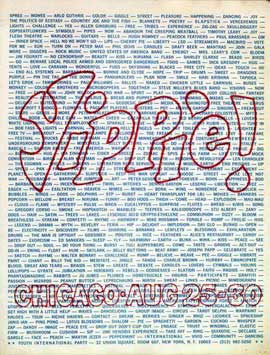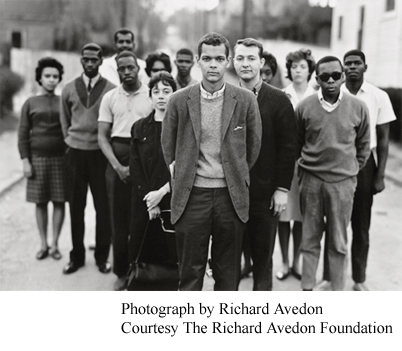An article from TIME magazine on April 5th, 1968, described the behavior of the YIPPIES saying,

"They poured into the vast main concourse of Manhattan's Grand Central Station 3,000 strong, wearing their customary capes, gowns, feathers and beads. They tossed hot cross buns and firecrackers, and floated balloons up toward the celestial blue ceiling. They hummed the cosmic "Ommm," snake-danced to the tune of Have a Marijuana, and proudly unfurled a huge banner emblazoned with a lazy "Y", and continued saying, "A dozen youths scaled the information booth, ripped off the clock hands, scribbled graffiti and defiantly passed around lighted marijuana "joints" in full view of the Tactical Patrol Force."
 Although Hoffman, had history with the Student Nonviolent Coordinating Committee during the Civil Rights Movement, that organization's reputation of wearing collared shirts and skirts was not present in the physical appearance of the YIPPIE demonstrators. In contrast to the dignified look of the SNCC, the YIPPIES, namely Jerry Rubin and Abbie Hoffman often characterized themselves with a more radical appearance.
Although Hoffman, had history with the Student Nonviolent Coordinating Committee during the Civil Rights Movement, that organization's reputation of wearing collared shirts and skirts was not present in the physical appearance of the YIPPIE demonstrators. In contrast to the dignified look of the SNCC, the YIPPIES, namely Jerry Rubin and Abbie Hoffman often characterized themselves with a more radical appearance. 

"Yippie Guru Abbie Hoffman, 32, cadged dinner from his four police tails, yipped up a storm in Lincoln Park (where he passed out phone numbers of cops and city officials for telephonic harassment), and was ultimately arrested for wearing a four-letter word on his forehead."Former cop Mel Latanzio describes,
“There was no distinguishing hippies, Yippies, Diggies, SDSers, and all of those radical groups. They went under different names, but we kept our eyes on all of them. I think they were pretending that they were different at times, but that was just a ploy, because when they got on the street, they all behaved the same way. Your regular patrolman was not going to be able to tell these people apart, and they didn’t seem to care what we thought, anyway; even if they weren’t trouble, they wanted to look the part.”
In an article from TIME magazine on December 6th, 1968, it was reported that,
"Police are not normally apt to be shocked by four-letter words. But, as in the Columbia University uprising last spring, they were outraged to see obscenities printed on placards or hear them shouted by apparently well-educated, middle-class young men and women. The barrage of epithets helped convince some policemen that their opponents were scarcely human—and they all too often shed their own humanity. Witnesses frequently noted that if a demonstrator being chased by police got away, the cops would simply club whoever else was handy."The YIPPIES aimed to celebrate their counter culture by holding "a six-day 'Festival of Life' in comic contrast to what they call the Democratic Party's 'National Death Convention'." Their satirical comedy continued when the YIPPIES attempted to nominate their own presidential candidate. Using a play on words, the YIPPIES presented their candidate, "Lyndon Pigasus Pig", in reference to the term "Pig" used to describe any cop. This stunt resulted in the arrest of Jerry Rubin along with six other demonstrators.

Not only did the demonstrators distinguish themselves with counter culture garb, they also made sure to proceed their presence in Chicago with a host of threats.
In the same article from TIME magazine on December 6th, 1968, explained how these threats were perceived saying,
"Mayor Richard Daley and his police and military aides appeared to accept at face value all of the fiery statements made by the demonstration leaders. Chicago's newspapers repeatedly listed diabolical threats aimed at the city, ranging from burning Chicago down by flooding the sewers with gasoline, to dumping LSD in the water supply, to having 10,000 nude bodies float on Lake Michigan."Although those threats were never realized, among the demonstrators were some lightly armed activists, according to TIME magazine,
"many were equipped with motorcycle crash helmets, gas masks (purchasable at $4.98 in North Side army-navy surplus stores), bail money and anti-Mace unguents. A handful of hard-liners in the "violence bag" also carried golf balls studded with spikes, javelins made of snow-fence slats, aerosol cans full of caustic oven-cleaning fluids, ice picks, bricks, bottles, and clay tiles sharpened to points that would have satisfied a Cro-Magnon bear hunter."

However it is also clear that radicals like Jerry Rubin and Abbie Hoffman are quite aware of the way in which they are perceived. In this quote from Hoffman, his understanding is made particularly clear,
“We are working on a huge Youth Festival in Chicago at the time of the Democratic Convention. I hope to get to participate. I’m currently on trial for supposedly hitting a cop with a bottle in a demonstration. I can’t imagine what they are talking about, me being a flower child and all that.”
Above is a discussion between activist Jerry Rubin and host Phil Donahue.
Mayor Richard Daley's public sentiment before the start of the convention was, 
Whether the sentiment from this public statement made by Mayor Daley was to be upheld throughout the convention had yet to be seen. From the book Battleground Chicago by Frank Kusch, the force of the Chicago police is outlined,

Above is a clip of the tension between Mayor Daley and the Democratic party inside the Convention Center.
"It is only fitting that during this dynamic democratic process, there is present in our city a cross-section of representation of the voices of America—liberal, moderate, conservative, and radical, young and old, hawk and dove, hippy and square … and this is the way it should be because this is America."

Whether the sentiment from this public statement made by Mayor Daley was to be upheld throughout the convention had yet to be seen. From the book Battleground Chicago by Frank Kusch, the force of the Chicago police is outlined,
"The usual police contingent of 6,000 officers on the streets grew to 11,900 on twelve-hour shifts, up from the usual eight. The city requested the mobilization of 5,649 Illinois National Guardsmen, with an additional 5,000 on alert, bolstered by up to 1,000 Federal Bureau of Investigation (FBI) officers and military intelligence officers. Waiting for signs of trouble in the suburbs would be 6,000 army troops, including members of the elite 101st Airborne Division. The men were to be equipped with bazookas and flamethrowers."


Above is a clip of the tension between Mayor Daley and the Democratic party inside the Convention Center.
Former Officer Warren MacAulay remembers,
Cop Ray Mihalicz speaks to the growing tension saying,
Yet, not all cops were outspokenly awaiting the confrontation. Officer Grant Brown explained,

Mayor Daley stood by his commitments proclaiming, "Law and order will be maintained", he also stated his case against the demonstrators, whom he referred to as "terrorists", explaining that they "use the foulest of language that you wouldn't hear in a brothel house."
To further illuminate his righteousness and ward off attacks upon his "Gestapo" tactics, Mayor Daley distributed "We Love You Daley" signs inside the convention center.
Neither side appeared to maintain an open mind. The demonstrators became as outrageous as possible. Smoking pot in front of cops, nominating a pig for president and one printed a certain four letter word across his forehead; these weren't exactly the characteristics of peace makers. In opting to wear only the clothes that defined their counter culture movement, making a mockery of the system with whom they would soon be in contact and sending absurd threats towards the city, they closed down nearly all opportunities for communication.
The cops also joined in the hostilities. They were surrounded by increased levels of police power. With flamethrowers and bazookas in their position, their mission was clear. Mayor Daley had them convinced that they needed to maintain order and let no one take over their city. The threats they heard were internalized, no matter how absurd, and the mixture of fear and animosity towards the demonstrators created a dangerous mentality. There would be little time or consideration for discussion.
“I know people who wore a uniform who really didn’t care—they hated the entire generation and they used any excuse they could find to go after them and teach them a lesson. These Yipps with their tough talk were making that very easy for some of the members."
Cop Ray Mihalicz speaks to the growing tension saying,
“I remember the years before—the radicals used to wear black all over or turtlenecks when it was hot enough to fry an egg on the hood of your car and sunglasses on cloudy days. By the time the war heated up, mid-decade, I suppose, the bad ones and the normal kids—if you can call them normal—all looked the same. It was like they wore this uniform that said, ‘I don’t belong in this society, look out for me.’ They might as well put a bull’s eye on their back.”
Yet, not all cops were outspokenly awaiting the confrontation. Officer Grant Brown explained,

“The problem for all of us was that we didn’t know what or where the hit was going to come from. We worried about the delegates, we worried about the infrastructure, the power, the water, and worried about them putting acid in the water—we didn’t know what was going to happen, and there was fear, all right, as silly as some of that fear may seem now.”
Mayor Daley stood by his commitments proclaiming, "Law and order will be maintained", he also stated his case against the demonstrators, whom he referred to as "terrorists", explaining that they "use the foulest of language that you wouldn't hear in a brothel house."
To further illuminate his righteousness and ward off attacks upon his "Gestapo" tactics, Mayor Daley distributed "We Love You Daley" signs inside the convention center.

Neither side appeared to maintain an open mind. The demonstrators became as outrageous as possible. Smoking pot in front of cops, nominating a pig for president and one printed a certain four letter word across his forehead; these weren't exactly the characteristics of peace makers. In opting to wear only the clothes that defined their counter culture movement, making a mockery of the system with whom they would soon be in contact and sending absurd threats towards the city, they closed down nearly all opportunities for communication.
The cops also joined in the hostilities. They were surrounded by increased levels of police power. With flamethrowers and bazookas in their position, their mission was clear. Mayor Daley had them convinced that they needed to maintain order and let no one take over their city. The threats they heard were internalized, no matter how absurd, and the mixture of fear and animosity towards the demonstrators created a dangerous mentality. There would be little time or consideration for discussion.

2 comments:
Interesting to see Jerry Rubin - surprisingly inarticulate! Doesn't really make clear points, just rails against The Man. Shame really.
I agree! I did expect more from him. He begins good points but doesn't finish them.
Post a Comment